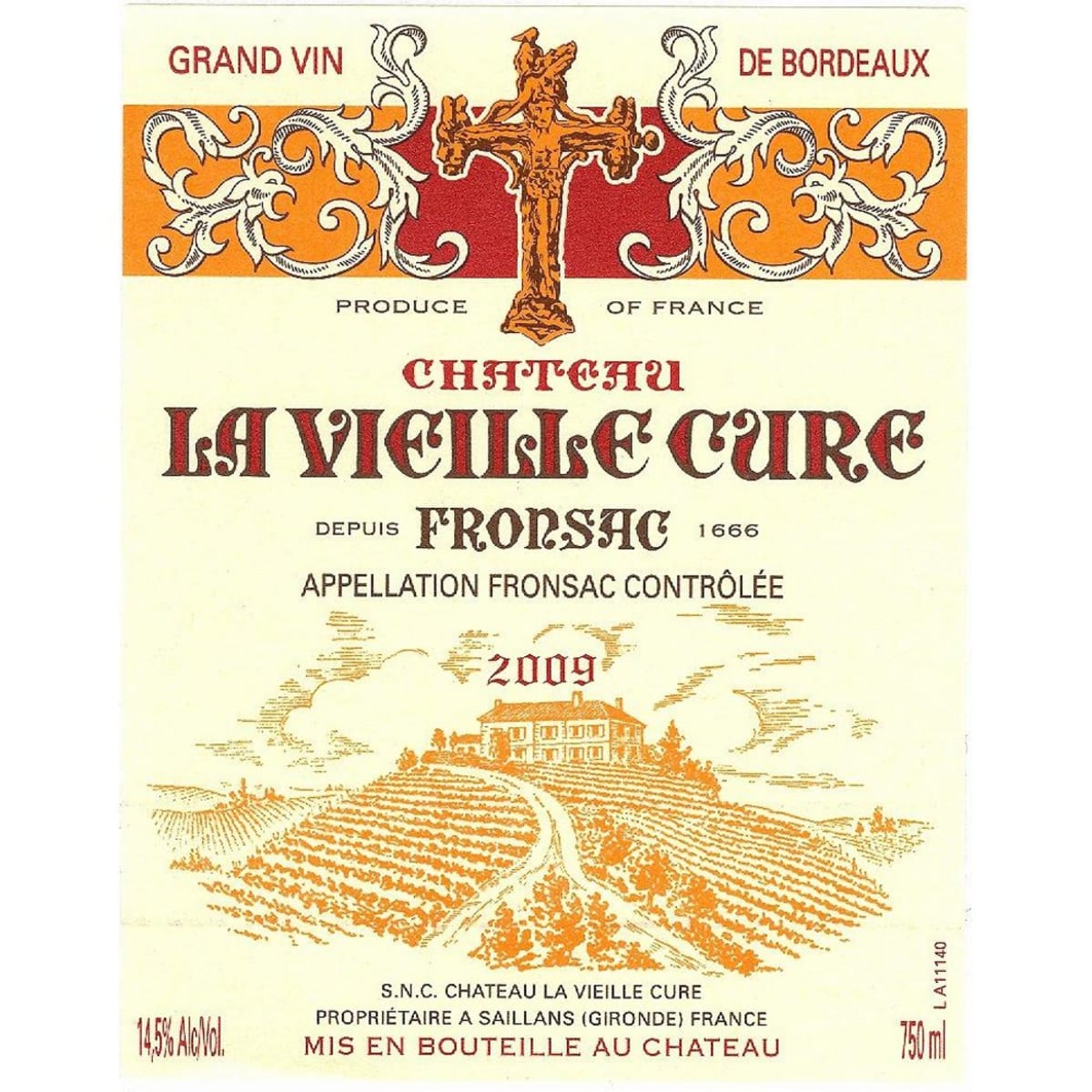Chateau La Vieille Cure 2009
-
Robert
Parker -
Wine
Enthusiast -
Wine
Spectator


Product Details
Your Rating
Somm Note
Winemaker Notes
Professional Ratings
-
Robert Parker's Wine Advocate
This property has made so many fine efforts lately that it is difficult to say the 2009 is better than their 2005. However, the 2009 is a charming, sexy, dense ruby/purple-colored offering displaying lots of ripe Merlot fruit intermixed with hints of charcoal, black raspberries, black currants, lead pencil shavings and truffles. This full-bodied, pure, nicely textured and layered Fronsac is a sleeper of the vintage that considerably over-performs for its modest price. Drink it over the next 15+ years. This is an obvious great value!
-
Wine Enthusiast
Good dusty tannins, lively fruit, a wine that seems very complete. There is a touch of final wood and dark tannins.
Barrel Sample: 91-93 Points -
Wine Spectator
Solid, with a nice, pure beam of cassis and blackberry fruit subtly laced with licorice snap and tobacco notes. The polished finish has an iron accent in reserve. Should be a solid midterm ager. Merlot, Cabernet Franc and Cabernet Sauvignon. Drink now through 2018.
Other Vintages
2022-
James
Suckling -
Jeb
Dunnuck - Decanter
-
Wine
Enthusiast
-
James
Suckling -
Robert
Parker
-
Robert
Parker -
James
Suckling -
Jeb
Dunnuck - Decanter
-
Wine
Spectator
-
Jeb
Dunnuck -
James
Suckling -
Robert
Parker -
Wine
Spectator
- Decanter
-
Jeb
Dunnuck -
James
Suckling -
Robert
Parker
-
Wine
Spectator -
James
Suckling -
Jeb
Dunnuck -
Robert
Parker -
Wine
Enthusiast - Decanter
-
Jeb
Dunnuck - Decanter
-
James
Suckling -
Robert
Parker -
Wine
Spectator -
Wine
Enthusiast
-
Wine
Enthusiast -
James
Suckling -
Jeb
Dunnuck -
Wine
Spectator -
Robert
Parker - Decanter
-
Wine
Spectator -
Wilfred
Wong -
Jeb
Dunnuck -
James
Suckling -
Wine
Enthusiast
-
Wine
Spectator -
Robert
Parker -
James
Suckling
-
James
Suckling -
Robert
Parker -
Wine
Spectator
-
Wine
Spectator -
Robert
Parker
-
Robert
Parker
-
Robert
Parker
-
Robert
Parker -
Wine
Spectator
-
James
Suckling -
Robert
Parker
-
Robert
Parker




Château La Vieille Cure is a Bordeaux estate in the eastern Fronsac appellation. It makes a Merlot-dominant grand vin and second wine, blended with Cabernet Franc and small amounts of Cabernet Sauvignon. The château dates back to the 18th Century – it features on a prominent map of the region made in 1780. Wine production on the property has an even longer history with 17th Century parish records mentioning vineyards there.
The estate took its modern form when it was bought by Americans Peter Sachs and Colin Ferenbach in 1986. The duo built a new winery, replanted vines and enacted extensive renovations. La Vieille Cure stopped selling a portion of its wine in bulk to be sold under other labels and began exclusively estate bottling. Since the 1980s the wine went from being primarily sold regionally in Fronsac, to distribution in more than 25 countries.
The vineyard covers 20 hectares (50 acres) and, uncommonly for Bordeaux, is a single large plot. It is planted on a limestone plateau above the Dordogne river near Libourne. The landscape includes southwest exposed hills of chalk and clay sub-soils. The grapes are mechanically destemmed, hand-sorted, with maceration lasting three to four weeks. Fermentation takes place in temperature-controlled stainless steel tanks, while malolactic fermentation takes place in barrel.

One of the world’s most classic and popular styles of red wine, Bordeaux-inspired blends have spread from their homeland in France to nearly every corner of the New World. Typically based on either Cabernet Sauvignon or Merlot and supported by Cabernet Franc, Malbec and Petit Verdot, the best of these are densely hued, fragrant, full of fruit and boast a structure that begs for cellar time. Somm Secret—Blends from Bordeaux are generally earthier compared to those from the New World, which tend to be fruit-dominant.

Home of the very first remarkable Right Bank wines, dating back to the 1730s, Fronsac and Canon-Fronsac actually retained more fame than Pomerol well into the 19th century. Today these wines represent some of Bordeaux’s best hidden gems.
Fronsac is a very small region at an unusually high elevation compared to other Bordeaux appellations. Its vineyards unroll along the oak-dotted hills bordering the river’s edge, making it perhaps Bordeaux’s prettiest and most majestic countryside.
Merlot covers 60% of the vineyard acreage; the rest of the vines are Cabernet Franc and Cabernet Sauvignon. The Fronsac and Canon-Fronsac appellations are limited to the higher land where soils are predominantly limestone and sandstone. Lower vineyards along the Dordogne River mainly qualify for Bordeaux AOC status
The best Fronsac are deeply concentrated in ripe red and black berry; they have a solid mineral backbone and are rich and plush on the finish.
